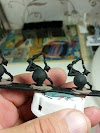Introduction
Photopea is an advanced image editor, which can work with both raster and vector graphics. You can use it for simple tasks, such as resizing images, as well as complex tasks, such as designing webpages, creating illustrations, processing photographs and more.
This website will teach you how to use Photopea step by step. We will start with basic tasks and gradually progress to more complex features. The chapters (on the left) have been organized, such that each chapter uses only the knowledge from previous chapters, so you can learn effectively and efficiently.
Colors
Right now, Photopea works with the sRGB color space (the basic color space for the web), with the 8-bit color depth. All exported files use sRGB, too.
Starting and using Photopea
Photopea editor works in a web browser. It can be started by going to www.Photopea.com. Photopea can run on any device (desktop, laptop, tablet, phone or any other computer), but for the best comfort, we recommend having a big screen, a precise pointing device (a mouse or a stylus) and a keyboard.
Photopea runs completely in your device, just like Sketch or Photoshop do. It does not upload any of your files to the internet. You can load Photopea.com, disconnect from the internet and keep using it completely offline. None of your files ever leaves your computer.
Opening and Saving files
Digital graphics is stored as a raster image, or a vector image. There are many formats for saving and distributing various types of graphics. Let's mention PNG and JPG, which contain a single-layer rectangular raster image (a grid of pixels).
Image editors use their own file formats, that contain raster and vector graphics, and additional information, which can be useful for changing the image in the future. For example, when we add a text into an image and save it as a PNG, letters would become pixels and such text would be hard to change (we would have to guess the font name, character size, the original image behind the letters would be lost).
Photopea uses the PSD format as the main format for storing image documents with an additional information. It was designed for the use in Adobe Photoshop and became very popular since then. All files, that you open in Photopea (such as PNG, JPG, Sketch) are converted to PSD (when they are not PSDs already). When you finish editing, the result can be saved from the PSD to other formats.
Photopea also supports many kinds of resources, that can be used for editing the image. You can load your own brushes, gradients, fonts and more, the same way you open images.
Opening files
There are several ways of opening files. The standard way is through the Open dialog (File - Open). You can also paste images (from the system clipboard) simply by pressing Ctrl + V. Another way is to open files by dragging them from your local system and dropping them into the Photopea environment inside a web browser.
When you have no documents opened, dropped files will be opened in a regular way. When some documents are already open in Photopea, you can drop new document into the main area of the current document. The new file will be inserted into the current document as a new layer (a Smart Object layer).
When some documents are opened, you can drop new files into the top bar of the main area (which contains the list of opened documents). Then, new files will be opened separately.
There is an experimental feature, which allows you take pictures using the camera of your device right inside Photopea. Press File - Take a picture to take a picture.










0 Yorumlar